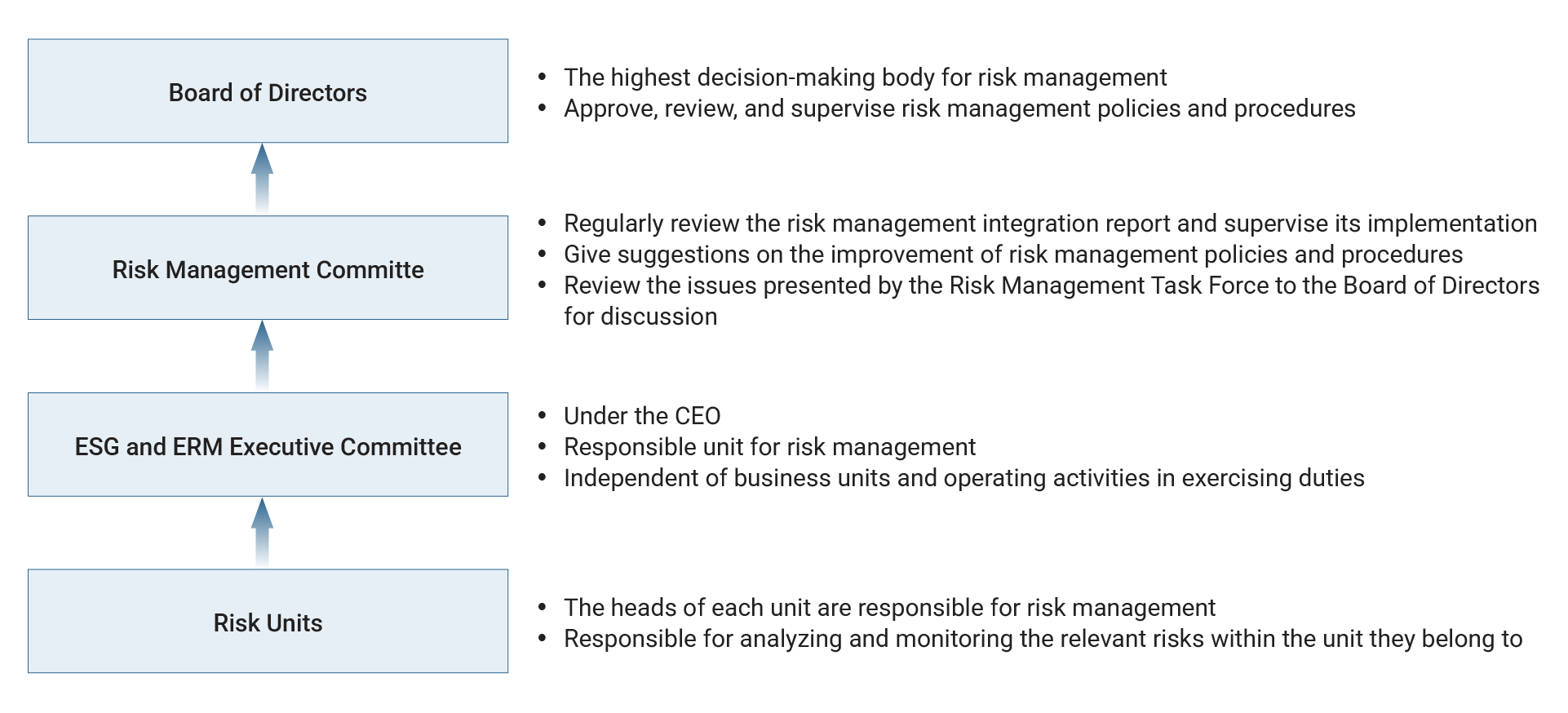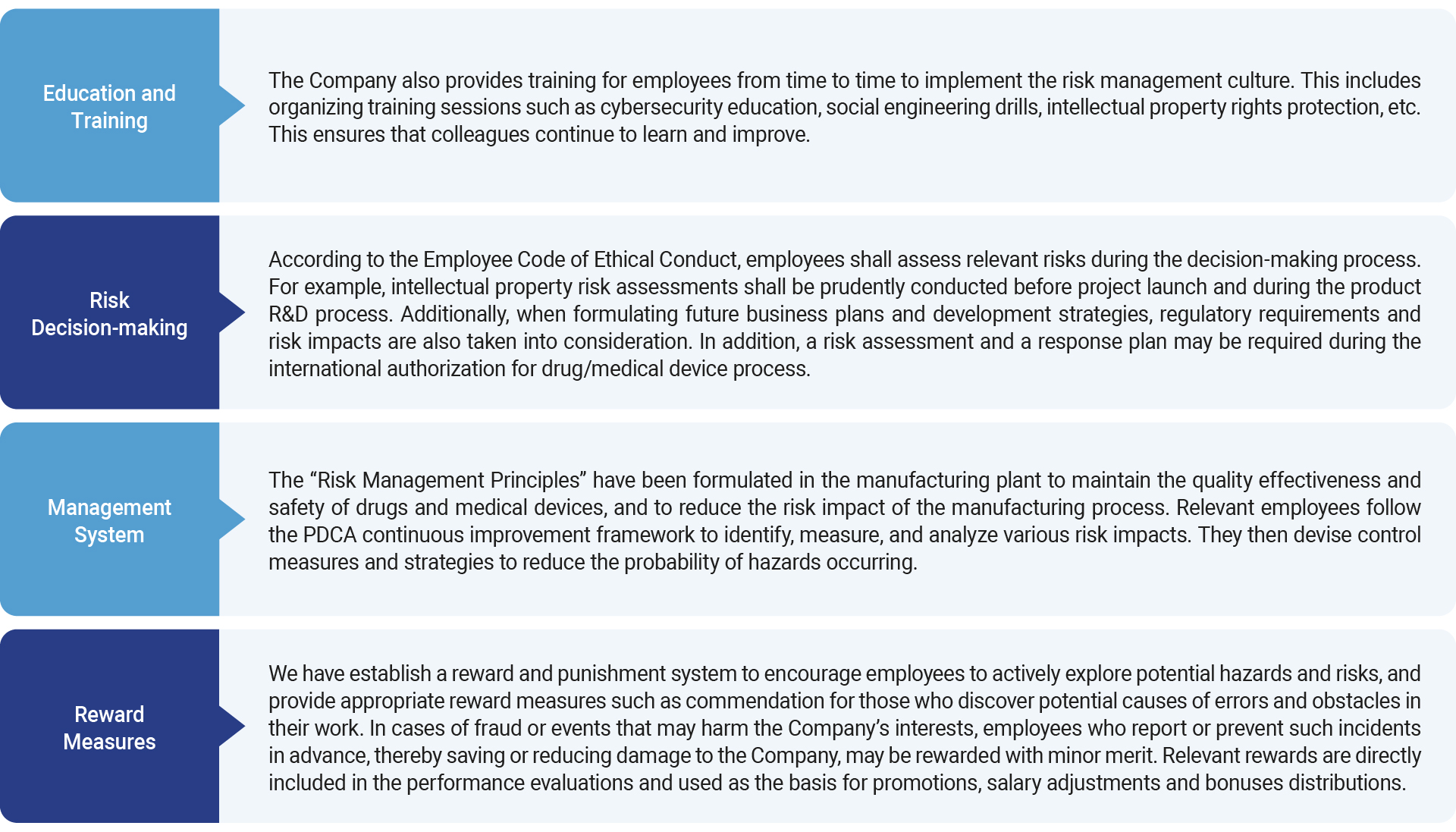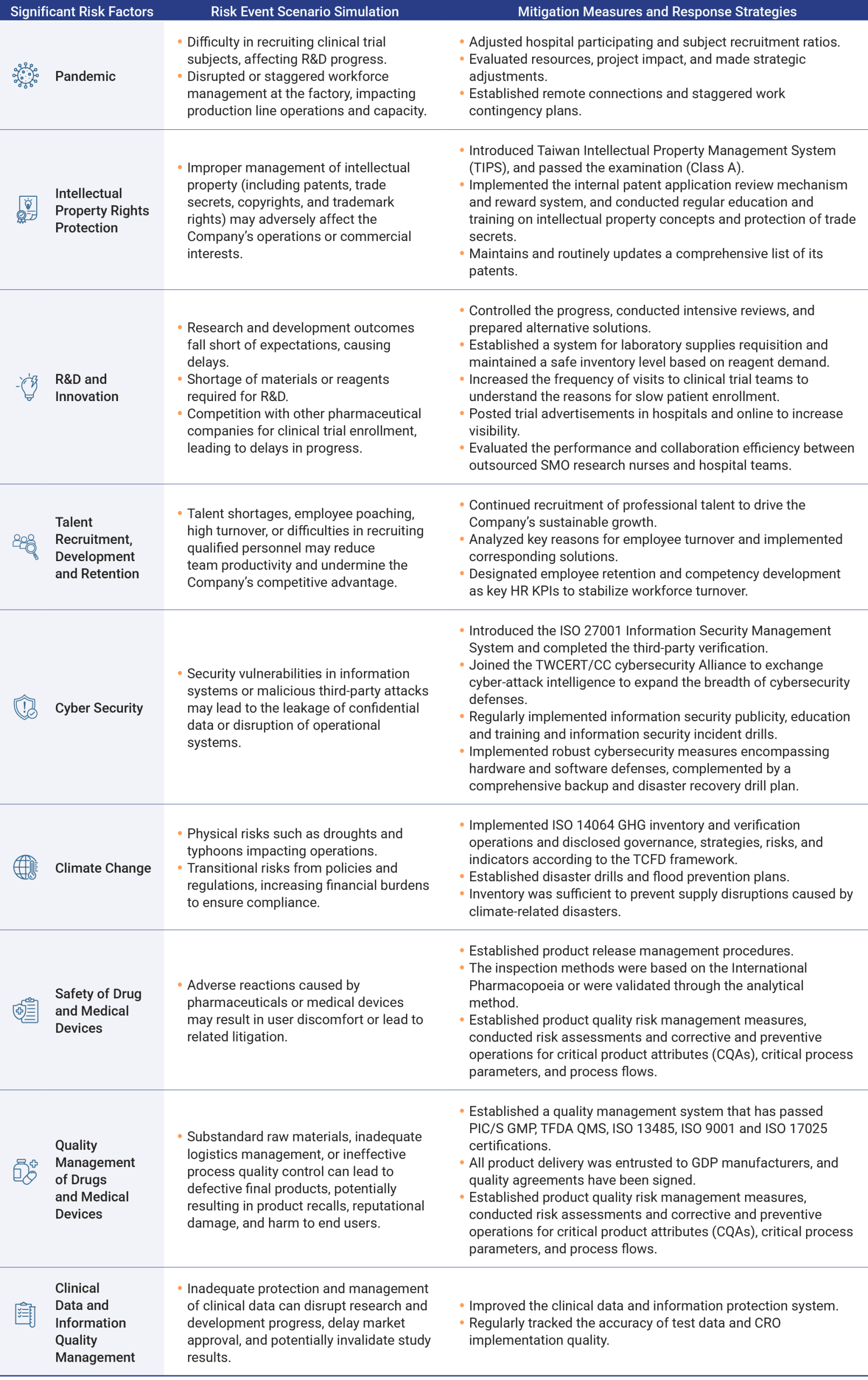The Company has established the “Risk Management Policies and Procedures” as the highest guiding principle for risk management.
The Board of Directors is the highest decision-making body for the risk management of Oneness Biotech, responsible for approving, reviewing, and supervising the Company’s risk management policies. Related organizations, policies, and procedures must be approved by the Board of Directors to ensure the effectiveness of risk management, and bear the ultimate responsibility. The Board of Directors was given authorization to establish the “Risk Management Committee”, composed of all independent directors.
The ESG and ERM Executive Committee is the unit responsible for the execution of risk management. The main responsibilities are execution-level matters in the supervision, evaluation and assessment of the Company’s risk. It shall exercise its duties independent from business units and operating activities, and shall report the operational status to the Risk Management Committee at least once a year. Starting from 2024, reports shall be submitted to the Risk Management Committee and the Board of Directors at least twice a year. At the beginning of each year, the report should cover the significant risks for the year and corresponding response measures, while at the end of the year, it should present the outcomes of risk management execution.





Each risk unit implemented risk management measures according to the formulated strategies. Throughout the year, no risks significantly impacted the Company’s operations. The results of the risk management efforts were reported to the Risk Management Committee and the Board of Directors on November 11, 2024.
In order to strengthen the management, control, and response to future risks, the Company not only predicts the aforementioned risks based on past experience, but also refers to literature published by domestic and foreign institutions to assess emerging risks to understand their possible impacts and formulate countermeasures.
The political situation worldwide has become unstable in recent years. The new US government initiated a trade war based on “Economic Nationalism”, imposing high tariffs on imported products in an attempt to protect its domestic industries, and these tariffs may include pharmaceutical products. If the US government implements drug import tariffs or non-tariff barriers in the future, it may have a significant impact on the Company’s export sales to the US market. Such policy change is out of our control and unpredictable, and its impact can be long-term and significant once it becomes effective. The potential impacts include:
The US market is one of the major markets targeted by the Company. If high tariffs are imposed on drugs, the Company’s price competitiveness for drugs exported to the US will decrease, and the Company may need to absorb some of the tariffs or adjust the product selling price.
High tariffs may result in a decline in sales volume in the US market, which in turn can affect the operating revenue and profit.
It may be necessary to reconsider the supply chain planning (e.g., setting up a factory in the US) or diversify the risk by entering other markets.
Such risk has a high degree of uncertainty, and the risk mitigation measures established by the Company include:
▲ Monitor policy changes continuously: Regularly track US trade policies and international status changes, in particular import and export measures related to the pharmaceutical industry.
▲ Diversify market planning: Actively explore other markets (e.g., Europe, Africa, Asia, etc.) to reduce the dependence on one single market.
▲ Supply chain flexibility: Engage in discussions and negotiations with overseas OEM factories to shift API production abroad, or through investment and cooperation, engage in acquisitions and mergers of existing local channels, to strengthen market presence and supply chain integration, and to adopt such methods as alternative solutions to sudden tariff changes.
Over the past years, the pharmaceutical industry has applied complex artificial intelligence models to analyze the mechanisms of diseases, in order to facilitate the understanding of potential diseases. The rapid development of Generative AI (GenAI) has changed the traditional R&D of drugs and application model of the pharmaceutical industry. The Company also understands GenAI’s ability to automate research, improve clinical trials, and reduce errors, can create benefits for the Company. However, we have also observed the emerging risks associated with GenAI:
The introduction of GenAI into new drug discovery and R&D may present AI technology challenges, such as algorithmic instability or lack of interpretability. In addition, the Company also needs talents equipped with professional knowledge of AI and new drug R&D at the same time, and such talents may be scarce in a short time.
The use of AI technology in new drug R&D may have an impact on the market competition. In particular, five new drugs in the Company’s pipeline are still in the clinical and pre-clinical stages. Competitors may develop drug molecules or antibodies of similar functions at a faster speed, causing the Company’s products to face the pressure of being a “fast-follower”.
The collection and commercialization of patient data (including genetic and social media information) may raise privacy and ethical concerns, and improper use of AI may cause risk to the Company’s reputation.
The extensive application of GenAI offers significant potential for the pharmaceutical industry; however, it remains crucial to further differentiate between reality and hype. Such risk has a high degree of uncertainty, and the risk mitigation measures established by the Company include:
▲ Invest in talent development and recruitment to ensure that the Company has sufficient professional knowledge and technologies.
▲ Establish partnerships with higher academic institutions and research institutions to stay abreast of new technologies.
▲ Maintain sensitivity to the market and competitive environment, and adjust strategies and business models in a timely manner.
▲ Strengthen cybersecurity and privacy management.
※The above content is taken from the ESG Report